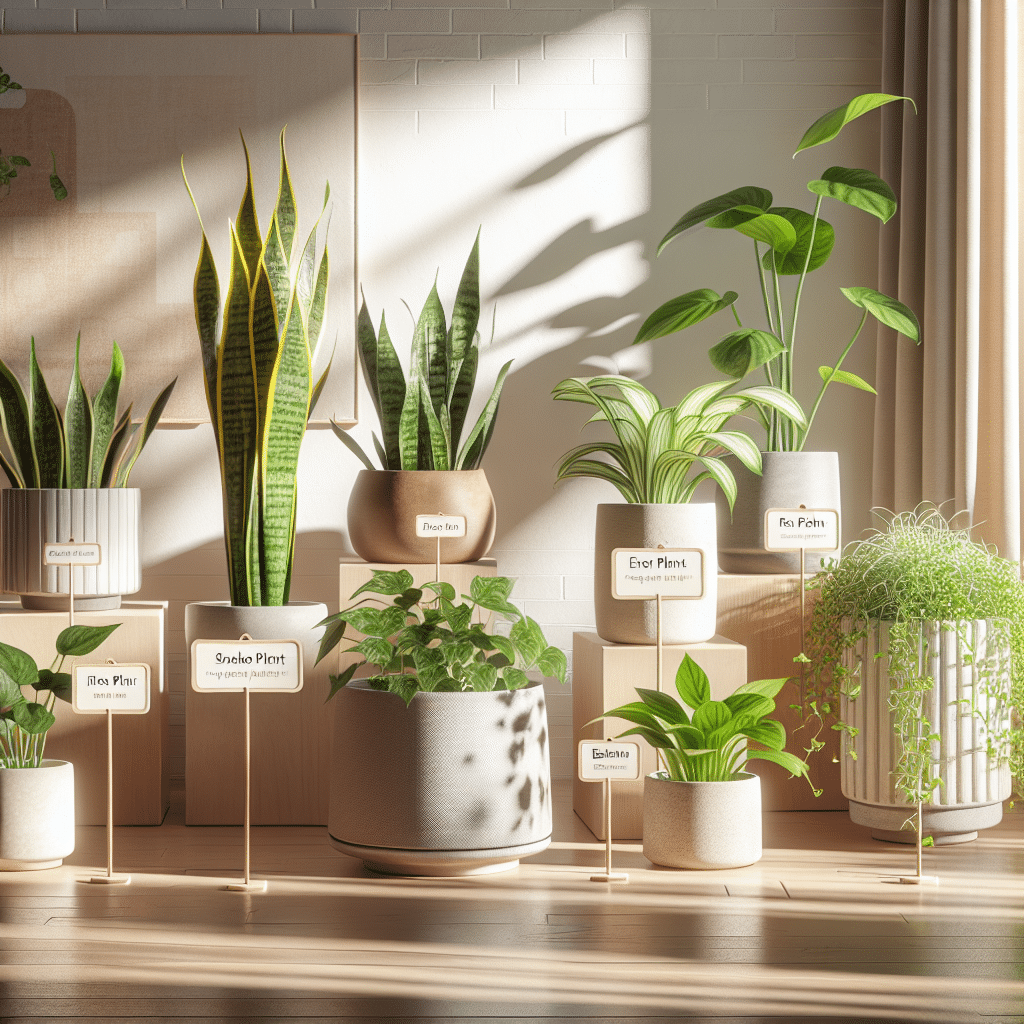Easy-Care Air-Purifying Plants for Busy Lifestyles
1. Snake Plant (Sansevieria)
The Snake Plant, also known as Mother-in-Law’s Tongue, is an ideal choice for busy individuals. It thrives on neglect and can survive low light conditions and infrequent watering. This hardy plant can purify indoor air by filtering out formaldehyde, benzene, and xylene. The Snake Plant converts CO2 into oxygen during the night, making it perfect for bedrooms. Its tall, sword-like leaves add a striking visual appeal to any space.
Care Tips:
- Water only when the soil is completely dry.
- Place in indirect light for optimal growth, but it can tolerate low light conditions.
2. Pothos (Epipremnum aureum)
Pothos is another resilient air-purifying plant, perfect for busy lifestyles. Known for its trailing vines and heart-shaped leaves, it adds a touch of greenery to shelves and countertops. Pothos effectively removes pollutants like formaldehyde and toluene from the air. It can thrive in a wide range of lighting conditions, from low light to bright, indirect light, thereby accommodating various environments.
Care Tips:
- Water when the top inch of soil feels dry.
- Trim regularly to encourage bushy growth and maintain its aesthetic.
3. Spider Plant (Chlorophytum comosum)
The Spider Plant is famous for its spider-like offshoots that resemble baby spiders. It’s an excellent air purifier and can remove carbon monoxide and other pollutants. Spider Plants are very forgiving and thrive on neglect. They do best in bright, indirect light, but can also adapt to lower light conditions.
Care Tips:
- Allow the top inch of soil to dry out between waterings.
- Feed with a balanced fertilizer every month during the growing season for optimal health.
4. ZZ Plant (Zamioculcas zamiifolia)
ZZ Plants are perfect for those who desire a low-maintenance option that still makes a statement. Its glossy, dark green leaves are not just beautiful but also work diligently to purify the air, effectively filtering out xylene, toluene, and benzene. ZZ Plants thrive in a variety of lighting conditions, from low light to bright indirect light, and require minimal watering.
Care Tips:
- Water sparingly; let the soil dry out completely before watering again.
- Rotate the plant occasionally to ensure even growth.
5. Peace Lily (Spathiphyllum)
The Peace Lily is not only attractive but also highly effective in air purification, removing harmful chemicals like ammonia and formaldehyde. It produces lovely white flowers that can brighten any indoor space. Peace Lilies prefer low to medium, indirect light and moist soil, making them somewhat more needy but still manageable.
Care Tips:
- Water when the soil feels dry to the touch.
- Mist leaves occasionally to enhance humidity and encourage flower growth.
6. Rubber Plant (Ficus elastica)
The Rubber Plant is a visually striking addition to your home. With its large, glossy leaves, it can reach impressive heights, adding elegance to any room. It’s also known for its ability to purify the air by absorbing toxins like formaldehyde. While it prefers bright, indirect light, it can adapt to lower light conditions, making it a versatile choice.
Care Tips:
- Water when the top inch of the soil is dry.
- Wipe the leaves regularly to remove dust and maintain its lustrous appearance.
7. Dracaena
Dracaenas come in many varieties, each with unique foliage that can enhance your home décor. They’re excellent at filtering indoor air pollutants and come in various sizes, making them suitable for both small and large spaces. Dracaenas thrive best in indirect light but can adapt to lower light environments, making them perfect for offices or dimly lit rooms.
Care Tips:
- Allow the soil to dry out before watering.
- Reduce feeding during the winter months, as plants grow slowly during this period.
8. Boston Fern (Nephrolepis exaltata)
Boston Ferns are known for their lush, feathery foliage that serves not only as a beautiful decoration but also as an effective air purifier. These ferns excel at removing formaldehyde and other toxins from the air. They thrive in humid environments and can be ideal for kitchens or bathrooms where humidity is higher.
Care Tips:
- Keep the soil consistently moist but not soggy.
- Mist the leaves regularly to maintain humidity levels.
9. Areca Palm (Dypsis lutescens)
The Areca Palm is a tropical plant that adds a vibrant touch to indoor spaces. It’s a superb air purifier, effectively removing toxins like xylene and toluene. Areca Palms thrive in bright, indirect sunlight and can also handle low-light conditions, making them versatile for various rooms in your home.
Care Tips:
- Water when the top inch of the soil is dry.
- Fertilize every few months during the growing season for healthy growth.
10. Bamboo Palm (Chamaedorea seifrizii)
The Bamboo Palm is a compact plant known for its ability to filter indoor air effectively. It’s particularly adept at removing benzene, formaldehyde, and trichloroethylene. This palm thrives in indirect light and can tolerate low-light conditions, making it ideal for dimly lit areas of your home.
Care Tips:
- Water when the soil is dry to the touch.
- Rotate the plant occasionally for even growth.
Including Plants in Your Home
Bringing easy-care, air-purifying plants into your home not only brightens your space but also contributes positively to your indoor air quality. With their low-maintenance requirements, they are perfect for busy lifestyles, providing both aesthetic appeal and health benefits. Whether you choose a Snake Plant, Pothos, or any of the other recommended plants, you’ll create a more vibrant living space that’s easier to maintain than ever before. Adopting a few of these plants can transform your environment while supporting your busy lifestyle.
